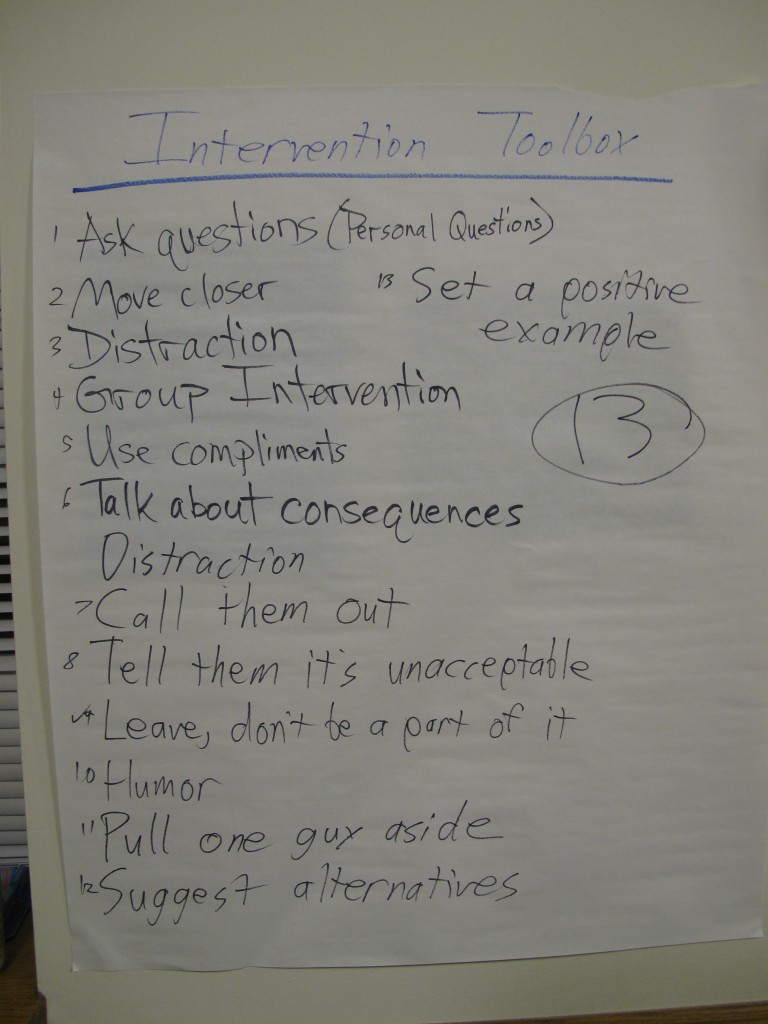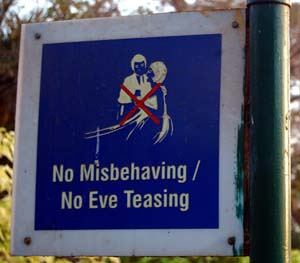While many harassers only harass women when they are alone or they harass women in such a way that no one else realizes what is happening, there are many times when they do blatantly harass women in front of others. Over and over women who have been harassed felt shocked or betrayed when no one around stopped to help.
Having a bystander say or do something could make a big difference in ending the harassment scenario, helping the woman not feel alone and safe, and making it clear that the harassing behavior is socially unacceptable.
Read stories about bystanders taking action.
Intervention Tips:
Suggestions from Brian Martin, professor of social sciences at the University of Wollongong, Australia, include:
If it looks like a man is bothering a woman, ask her, “Is someone bothering you?” That question alone may deter a harasser who believes no one will intervene. If she says yes and the harasser does not leave or persists harassing, tell the harasser to stop or call for assistance (from police, a transit authority worker, or other people nearby).
If a woman in a crowd says she has just been harassed or had someone touch her inappropriately, call out a supportive comment such as, “Whoever did that, it is not welcome,” or “We do not tolerate that behavior.”
If you see a woman who has been verbally or physically abused, you can ask her if there is anything you can do to help. If she says no, leave, because you do not want to be another person intruding on her space. If she says yes, try to help her as best you can.

Read suggestions from Men Can Stop Rape‘s Men of Strength Club event at Georgetown University on January 31, 2012.
Most of the male allies surveyed (82 percent) as part of research for the Stop Street Harassment book in Dec. 2009 said they would be willing to intervene when they see someone harassing a woman, 17 percent said they had intervened once, and 46 percent said they had intervened more than once. Their tips include:
I’ve found that distractions and indirect interventions help best. Asking for directions, asking for the time, or other innocuous questions can often be enough of a distraction for a harasser to go away and move on, without causing a big scene or putting anyone in physical danger.
I do not address the man/group harassing the female. I simply offer my presence.
You don’t have to be loud and physically confrontational. You can simply distract harasser by saying “waddup” or you can just stay in open view so it won’t escalate to a rape scenario.
Where possible, intervene by giving control to the target of the harassment (e.g. “is he bothering you?” or “are you okay?”).
Just do the right thing. I think there are times when a harasser may be intimidating even to other males, but you have to find the intestinal fortitude to stand up for women in these situations. Otherwise, it’s as if we are giving the harassers tacit approval to continue their behaviors.
Go in fast and loud and willing to do just about anything.
Be aware of the situation, know what your advantage is, and if confronting a group situation, make sure you are interacting with the leader, and have contacted the police.
Don’t turn a blind eye, confront them even if it’s awkward, even if it’s not socially acceptable, do it anyways…Remember that many women are not in the situation where they are safe speaking up for themselves.
Many of the suggestions that do not directly challenge a harasser, such as asking the woman if she wants help or asking the harasser what time it is, are excellent to use when one is not sure if it is harassment that is occurring, if they do not want to dis-empower the woman, or if they fear becoming the target of the harasser’s inappropriate behavior themselves. Something as simple as clearing one’s throat or coughing can help defuse a situation too, particularly if a harasser does not notice other people are around (such as on a dark street).
Other Resources:

There are many barriers that keep people, especially men, from preventing and intervening in street harassment and other incidents as often as they could. For example, if there are several other people around, the “bystander effect” may mean that each person expects the other to respond or that if no one responds, there is no need to or it must be inappropriate to do so. Other reasons for doing nothing may be because the a person is unsure if the behavior is unwelcome, doesn’t want to assume the person can’t take care of themselves, doesn’t know what to do, and/or fears the perpetrator will turn on them.
While these are legitimate concerns, since intervention often can make a difference, the benefits may out weigh the negatives. To learn more, consider attending workshops by groups like Men Can Stop Rape and Mentors in Violence Prevention (MVP).
Men Can Stop Rape’s Where Do You Stand campaign
Know Your Power Campaign & University of New Hampshire article “Sexual Violence Prevention Through Bystander Education: An Experimental Evaluation“
Hollaback’s bystander campaign “I’ve Got Your Back”
Brian Martin’s “Men: Help stop public harassment“
Jackson Katz’s The Macho Paradox: Why Some Men Hurt Women and How All Men Can Help
Todd Denny’s Unexpected Allies: Men Who Stop Rape
Martha Langelan’s Back Off! How to Confront and Stop Sexual Harassment and Harassers (see chapter 8: “Not All Men Harass: Men as Allies for Women”)
R. W. Connell’s Masculinities
Michael S. Kimmel’s Manhood in America: A Cultural History
Michael Kaufman and Michael Kimmel’s book The Guy’s Guide to Feminism
Bryon Hurt’s film “Hip-Hop: Beyond Beats and Ryhmes“
